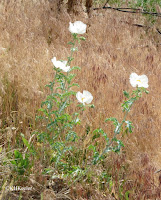 |
| The white flowers are Mentzelia nuda stickleaf in the late afternoon prairie |
For most of my career, I did research in the high plains of Nebraska and Colorado. I'd pack a sandwich and after breakfast, head to a remote prairie preserve to count and measure plants and insects throughout the day. Sometimes I made my own dinner, but more often I stayed at Cedar Point Biological Station just north of Ogallala, Nebraska, and I needed to head home in time to be included dinner at the Biological Station.
If the flowers of Mentzelia nuda were open, it was time to go.
Some plants have flowers that open only in the morning and wilt by midday, morning glories (Ipomoea tricolor) and wild flax (Linum) for example. Others open at night, such as moon vine (Ipomoea alba) and evening primroses (Oenothera spp.). Stickleaf opens in late afternoon and closes before dark. The most common plant I know with that flowering pattern is the four o'clock, Mirabilis jalapa.)
 |
| four o'clocks, Mirabilis jalapa |
 |
| Stickleaf, Mentzelia nuda, flowers |
 |
| Stickleaf flowers open. Taken at 4:40 pm. according to info on the photo |
The flowers close about dark, to reopen daily for several days.
My research on them began with establishing that the plants are not annuals but often live a few years (three but not ten). It led me to looking at the ants that climbed on the seed pods. After the petals fall, the nectary in the flower continued to put out nectar for some days. Ants often climbed up to drink it. I showed that the presence of the ants decreased damage to the developing seeds: plants with ants had fewer damaged seeds than the plants from which I experimentally excluded ants.
That led me to look at flowering and the insects that visit stickleaf. There was a white bee. Bees come in many colors, but white is rare. Stickleaf is a native wildflower: it had evolved a very specific pollinator that was camouflaged when visiting the bright white flowers. (Contrast the visibility of the bee in the flower in the third photo above to the beetle in the flower below.)
The project on pollination was annoying, however. Though it was lovely to study a pretty flower, the flowers were open only 4-8 pm each day. I wasn't going to miss dinner, so I had to miss the Biological Station's after-dinner volleyball game in order to observe open flowers. That was okay for a summer, but would not have been so okay every summer. Biologists will do strenuous and uncomfortable things--stay up all night to observe the pollinators of a night-blooming flower or hike across the prairie when the temperature is 104 to get important measurements--but we do have the good sense to get that data and then move on to projects that have working conditions that fit us individually. I, for example, could work through blazingly hot days but not when attacked by mosquitoes. My colleagues who studied lizard behavior could sleep relatively late every morning because lizards become active only as the summer day gets hot.
Stickleaf is one of some 73 members of the genus Mentzelia in the United States. They were named in honor of German botanist Christian Mentzel biography. It isn't a well-known group because they are plants of western North America, especially dry empty areas. Many species have very limited ranges (USDA maps: look at individual maps link). Yellow flowers are more common than white ones.
Mentzelia nuda grows well on sandy roadsides, but is out-competed by grasses and other more aggressive plants. It won't survive continuous trampling or disturbance either. So although it is quite visible on lightly disturbed roadsides in the late afternoon, it is rarely very common.
 |
| Dense stands are uncommon but spectacular |
Stickleaf is a good common name: the leaves have recurved hairs: you can just touch a leaf to someone's shoulder and the leaf stays. The students nicknamed it "velco leaf." The hairs make the leaves feel coarse but they don't stick you: they only stick to you.
It is a beautiful wildflower of the American high plains.
Comments and corrections welcome.It is a beautiful wildflower of the American high plains.
References
Keeler, K. H. 1981, Function of Mentzelia nuda (Loasaceae) post-floral nectaries in seed defense. American Journal of Botany 68 (2): 295-299.
A
Keeler, K.H. 1987. Survivorship and fecundity of the polycarpic perennial Mentzelia nuda (Loasaceae) in Nebraska sandhills prairie. American Journal of Botany 74 (6): 785-791.
Kathy Keeler, A Wandering Botanist
More at awanderingbotanist.com
My recent book NoCo Notables: 15 Northern Colorado Plants Worth Knowing Available at Amazon link highlights wild plants of the western plains
You might also like these blog posts about plants you might see where stickleaf grows:
Prickly poppy, Argemone polyanthemos link

Rocky Mountain beeplant, Cleome serrulata link





Can I quote yours with revealing the source?
ReplyDeleteYes. Posted on the internet, these articles are published and can, as you say, be quoted with the source included.
ReplyDeleteThank you.
Deletehttps://whatisinmyjunkdrawer.blogspot.com/2020/10/mentzelia-nuda.html